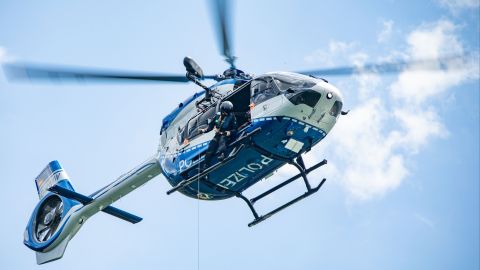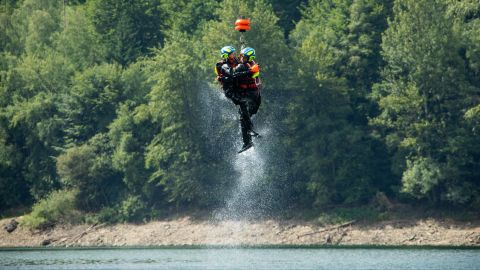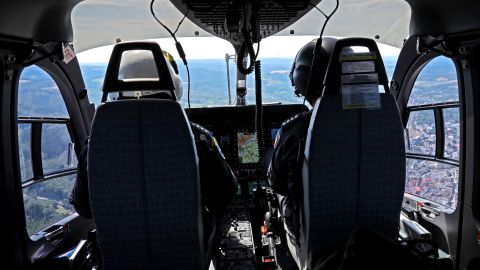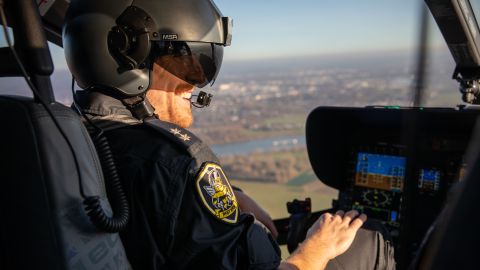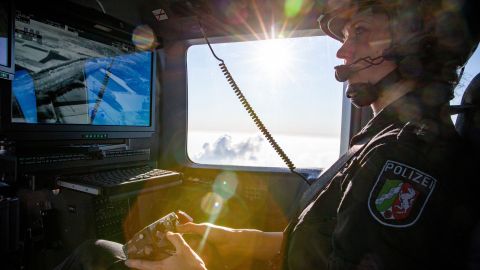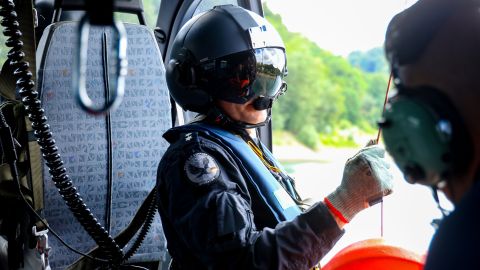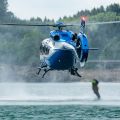The two pilots, Alexander Schaaf and Patrick Sievers, have been with the flying squadron for four years. Kathrin Buschkühl joined the team as an operator in April 2019. The helicopter is always flown by three people: while the pilot and co-pilot sit in the front of the cockpit, an operator operates the technology in the back of the helicopter. If you talk to the three of them, one thing quickly becomes apparent: Their great enthusiasm for their job. All three completed their police training and then gained their experience in various areas of the police force until they took the opportunity to move to the aviation squadron in Düsseldorf. "Flying has always been a childhood dream of mine. A relative of mine worked as a paramedic on a rescue helicopter. During my military service, I then worked in helicopter maintenance for the army air force. So the subject has been with me for a long time," explains Patrick Sievers.
Communication is everything
The helicopter is always deployed when colleagues on the ground need support from the air, for example when searching for missing persons or fleeing suspects, in the event of accidents or at demonstrations. Teamwork is absolutely essential here: the pilot, co-pilot and operator must be able to rely on each other blindly. The pilot's primary task is to fly the helicopter safely. He is supported by the co-pilot: The co-pilot monitors certain parameters, makes system inputs for the pilot and keeps an eye out for hazards such as high-voltage power lines or other aircraft. During the mission, he also communicates with the ground forces via radio. The pilot and co-pilot usually alternate in their roles after each mission. The operator's tasks include Taking photos and videos or using the thermal imaging camera to search for missing persons. "We have to coordinate well to be able to take usable images. Can the helicopter perhaps get closer to an object? Can the pilot perhaps turn it 90 degrees? Communication really is everything here," emphasizes POK Kathrin Buschkühl. She is currently the only woman on operational duty with the air squadron. After taking part in an information day on site, she knew immediately: "If I could work here, I would really have arrived!" She remembers her first mission in April 2019: the helicopter was called to Duisburg by the water police to deal with a water pollution incident. The task: to find the person responsible and secure evidence. As POK Kathrin Buschkühl had only just started her five-month training as an operator, she flew alongside an experienced operator. "He opened the rear door of the helicopter and stood on the skid with the safety harness so that he could take better pictures. I was incredibly impressed by his professional, considered and safety-oriented actions," says Buschkühl. However, POKin Buschkühl is not only used to lofty heights as an operator: she has had a private pilot's license herself for three years and flies a Cessna 172 in her spare time.
Rescue at the last second
A particular challenge for the team are missions that involve human lives. For example, searching for drowning people in the Rhine is a difficult task. Because every minute counts here. The crew knows that they might still be able to save someone. "When you then hear on the radio that the person has just been spotted, even the helicopter can feel pretty slow at a time like that," says Patrick Sievers. Alexander Schaaf and Kathrin Buschkühl also remember a joint mission in November 2019, in which they were on the ground as pilot and operator: An elderly man was missing in the Münster area. The ground forces request the helicopter for assistance. The problem: as the team had previously been on another mission, the fuel tank was no longer full. In order to be able to carry out the search for the missing man safely and successfully, the tank contents are calculated precisely. The crew searches a large area from the air - yet the man remains missing. Every minute, the team has to jointly assess whether they can continue searching or have to call off the search without success. "It was clear to everyone that the man would probably not survive the night in the low outside temperatures if we didn't find him," says POK Kathrin Buschkühl. Shortly before they have to give up the search, the operator discovers something after all: via the thermal imaging camera, she sees a person lying motionless on his back in a remote, impassable stretch of forest. The co-pilot manages to guide the ground forces to the right place. On take-off, the team sees how the man can be lifted up by colleagues on the ground and taken to the ambulance. Thanks to the precise calculation, the helicopter arrives safely at the alternative airport selected for refueling, Münster-Osnabrück. POK Alexander Schaaf: "That was a great feeling. On missions like this, everything really has to go hand in hand: You have to work quickly, but still safely. Especially in situations like this, you realize how hard everyone is working towards a common goal."
New area of responsibility: firefighting
In future, NRW police helicopters will also be used to fight forest fires. For this purpose, a mobile, foldable water tank ("Bambi Bucket") will be attached under the helicopter, which can then be emptied over the fire area. In addition to two pilots and an operator, POK Kathrin Buschkühl was also trained as a multiplier. Over the coming weeks and months, she will train her colleagues in how to use the bucket. "This is an exciting new area of operation that I'm really looking forward to. It's great to be able to support the fire department in their operations too," says the operator.
Lifelong learning
If you want to become a pilot in the air squadron, you need perseverance above all else, as you first go through a multi-stage selection process. Training to become a professional pilot then takes around two years at the Joint Aviation School for the Police Service in Sankt Augustin near Bonn. It starts there with a seven-week English course, followed by theoretical and practical training components. "That's quite exhausting. But parallel to the theoretical training, you're already where you want to be: sitting in the cockpit and piloting a helicopter - albeit initially as a student pilot alongside a flight instructor," recalls POK Patrick Sievers. After completing their flight training, however, the pilots are not yet cleared for all tactical flight procedures. For example, POK Patrick Sievers and POK Alexander Schaaf only just successfully completed their advanced training for night flying in December, after a year of operational experience. "Basically, you are constantly confronted with new tasks here - the learning never stops," emphasizes POK Alexander Schaaf.
Putting their heart and soul into it
All three agree: the job at the Air Wing is their absolute dream job. The combination of police work and aviation, the close cooperation within the team, the exciting missions throughout NRW - and last but not least, the breathtaking view from the helicopter cockpit are things they would not want to do without. They are happy to give tips to interested colleagues: "There are always rumors circulating that you have to be a math or physics genius. That's not true. You should have a certain basic understanding of science and technology. However, it's much more important that you have enough stamina during your training - then nothing really stands in the way of you joining the flying squadron," says POK Alexander Schaaf.
